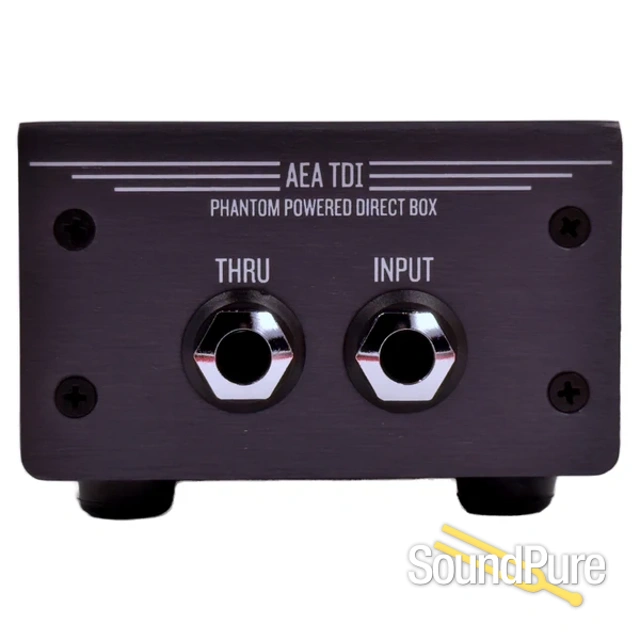-
Call Us Toll Free888-528-9703
-
Local/International (+1)919-682-5552
- Call Us! Toll Free! 888-528-9703
- Local / International (+1) 919-682-5552

AEA TDI Phantom-Powered Direct Box From AEA
With a proprietary circuit design by Fred Forssell and a superclean Lehle step-down transformer, the ultra-transparent TDI can capture outstanding sonic performances with minimal distortion, noise interference, and signal loss from long cable runs.
$299.00
"Experience the Difference"
 Payments as low as $26/mo.
Payments as low as $26/mo.
Manufacturer's Description from AEA
TDI OVERVIEW:
- Super clean and musical circuit design
- Compact, road-ready design with rugged durability
- 20 dB pad, ground lift switch, and paralleled throughput
- Made in the U.S.A
Simple, straightforward design
Inspired by our straightforward design philosophy and our desire to offer an outboard DI alternative, we created the AEA TDI.
The phantom-powered TDI offers a passive THRU-put connection which allows the user to send incoming instrument signal to other instrument-level sources (amplifiers, pedals, etc.). This throughput feature, paralleled to the INPUT, is also useful for simultaneous wet/dry signal tracking.
The TDI pairs well with passive instruments (i.e. guitars, basses, piezo pickups) but, with a 20 dB pad, it can also handle signals from active instruments, synths, or speakers.

About Manufacturer
Wes Dooley's longtime passion for audio has infused his company, Audio Engineering Associates (AEA), with a well balanced blend of creativity and technical expertise for forty years. At the core of AEA is a genuine interest in the art and science of audio. From areas as diverse as forensic audio and microphone design, Wes' passion for audio has led him all over the world, from recording experiences in Europe, Africa, and New Zealand, to the courtrooms of Los Angeles as a forensic audio and video expert witness. Such experiences have led Wes to design products which help resolve problems commonly encountered by recording engineers. His portable recording tools including, multi-channel microphone arrays, MS stereo processors, stereo phase displays and very tall microphone stands, have all made on-site recording far more feasible. Despite his contributions to on-location recording, Wes is best known for his pursuit of excellence in ribbon microphone technology. After two decades of representing and servicing the BBC 4038 in the United States, he began to experiment with his own ribbon microphones. During the last decade Wes became aware of the increasing scarcity of R44's and other ribbon microphones. In 1998, responding to this need, Wes re-introduced the 44 much to the thrill of many in the recording industry. Les Paul told Wes that AEA's R44 is his favorite microphone and engineer/producers such as Bruce Swedien, Kevin Bacon, and Shawn Murphy routinely use AEA's R44. Even without such critical acclaim the numbers speak for themselves. Over half of the movies scored in Los Angeles have a 44 somewhere on the scoring stage. Building off of his successful reintroduction of the R44, in 2002 Wes designed and began producing an original ribbon mic, the AEA R84. His groundbreaking work with ribbon microphones helped him to secure the Audio Engineering Society (AES) Silver Medal Award in the fall of 2003. This award, established by the AES in 1971, in honor of audio pioneers Alexander Graham Bell, Emile Berliner, and Thomas A. Edison, is given in recognition of outstanding development or achievement in the field of audio engineering. Wes has also co-authored two AES Journal articles about stereo microphone techniques, chaired workshops on mic techniques and mixing strategies for compatible multiple releases for cinema, broadcast and home video, and has presented section meetings on stereo techniques and forensic audio. He is involved with AES standards work and currently serves on the SC-03-12 Working Group on Forensic Audio and SC-04-04 Working Group on Microphone Measurement and Characterization.












